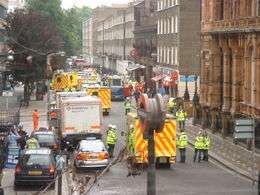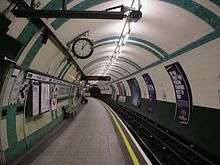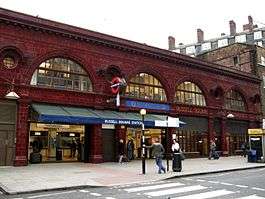Russell Square tube station
| Russell Square | |
|---|---|
|
Station entrance | |
 Russell Square Location of Russell Square in Central London | |
| Location | Russell Square |
| Local authority | Camden |
| Managed by | London Underground |
| Number of platforms | 2 |
| Fare zone | 1 |
| London Underground annual entry and exit | |
| 2012 |
|
| 2013 |
|
| 2014 |
|
| 2015 |
|
| Railway companies | |
| Original company | Great Northern, Piccadilly and Brompton Railway |
| Key dates | |
| 15 December 1906 | Station opened |
| Listed status | |
| Listing grade | II |
| Entry number | 1401730[2][3] |
| Added to list | 20 July 2011 |
| Other information | |
| Lists of stations | |
| WGS84 | 51°31′23″N 0°07′28″W / 51.5231°N 0.1244°WCoordinates: 51°31′23″N 0°07′28″W / 51.5231°N 0.1244°W |
|
| |
Russell Square is a London Underground station on Bernard Street, Bloomsbury in the London Borough of Camden. The station is on the Piccadilly line, between Holborn and King's Cross St Pancras and is in Travelcard Zone 1.[4] It is a small but busy station, often used by office workers and by tourists who are staying in Bloomsbury's numerous hotels or visiting the British Museum.
Russell Square Station is not far from the British Museum, the University of London's main campus, Great Ormond Street Hospital, Russell Square Gardens & the Brunswick Centre.[5]
History
The station was opened by the Great Northern, Piccadilly and Brompton Railway on 15 December 1906.[6] The station was designed by Leslie Green.[7] On 20 July 2011, English Heritage gave the station buildings Grade II listed status, describing it as:
a good example of a station designed by Leslie Green to serve the GNP & BR, later the Piccadilly Line, retaining original tiled lettering. The interior, while altered, features of interest survive at lower levels including tiling and directional signage. The Yerkes group of stations designed by Leslie Green illustrate a remarkable phase in the development of the capital's transport system, with the pioneering use of a strong and consistent corporate image; the characteristic ox-blood faience façades are instantly recognisable and count among the most iconic of London building types.
2005 London bombings

On 7 July 2005, in a co-ordinated bomb attack, an explosion in a train travelling between King's Cross St. Pancras and Russell Square resulted in the deaths of 26 people,[8] making up nearly half of the total fatalities from the series of attacks and also causing damage to the tunnel. It was the last of the three bombs used in the attacks on the underground, although another bomb later exploded on a bus.[8]
A plaque remembering the victims, identical to the one at King's Cross St Pancras tube station, is located at the station[9]
The Station today
The station is a Grade II listed building.[2][3]
Russell Square station has three lifts[10] and are all fifty-passenger lifts built by Wadsworth.[11] However, there are no escalators but the platforms can still be reached using a spiral staircase with 171 steps. It is said that the signs at the station indicate an incorrect number of steps, which is 175 steps.[12]
The station has 4 payphones (two on the platforms and two in the ticket halls),[10] 7 gates, a Wifi service,[13] 5 vending machines and a photo booth.[10]
Platform level tiling

The stations along the central part of the Piccadilly line, as well as some sections of the Northern line, were financed by Charles Yerkes,[14] and are famous for the Leslie Green designed red station buildings and distinctive platform tiling. Each station had its own unique tile pattern and colours.
Services and connections
Train frequencies vary throughout the day, but generally operate every 4–7 minutes between 06:06 and 00:28 in both directions.[15][16]
London Bus routes 7,, 10, 59, 68, 91, 98, 168, 188 and X68 and night routes N7, N91 and N98 serve the station.[17][18]
In popular culture
Russell Square tube station was used as the location for the 1973 horror film entitled "Death Line"[19] which starred Donald Plesence, Christopher Lee and Clive Swift.
See also
- British Museum
- University of London
- Great Ormond Street Hospital
- Russell Square Gardens
- Brunswick Centre
Books and References
Books
- Rose, Douglas (1999) [1980]. The London Underground, A Diagrammatic History. Douglas Rose/Capital Transport. ISBN 1-85414-219-4.
- Wolmar, Christian (2005) [2004]. The Subterranean Railway: How the London Underground Was Built and How It Changed the City Forever. Atlantic Books. ISBN 1-84354-023-1.
References
- 1 2 3 4 "Multi-year station entry-and-exit figures" (XLS). London Underground station passenger usage data. Transport for London. April 2016. Retrieved 3 May 2016.
- 1 2 3 Historic England. "Russell Square Underground Station (1401730)". National Heritage List for England. Retrieved 3 April 2015.
- 1 2 "16 London Underground Stations Listed At Grade II". English Heritage. 26 July 2011. Archived from the original on 2011-09-14.
- ↑ Transport for London (January 2016). Standard Tube Map (PDF) (Map). Not to scale. Transport for London. Archived (PDF) from the original on 3 January 2015.
- ↑ Google Maps – Russell Square Tube Station
- ↑ Rose 1999.
- ↑ Wolmar 2005, p. 175.
- 1 2 July 7 2005 London Bombings Fast Facts
- ↑ http://www.londonremembers.com/memorials/bombs-7-7-05-piccadilly-line-wc1
- 1 2 3 Russell Square Tube Station – Facilities
- ↑ Lifts at Russell Square Tube Station London – Youtube
- ↑ Tube Facts – Tube Stations that have no escalators and use lifts to get down to the platforms & Tube Stations with steps
- ↑ Russell Square Underground Station
- ↑ http://www.londonreconnections.com/2010/the-man-who-painted-london-red/
- ↑ "Piccadilly line timetable: From Russell Square Underground Station to King's Cross St. Pancras Underground Station". Transport for London. Retrieved 22 February 2015.
- ↑ "Piccadilly line timetable: From Russell Square Underground Station to Holborn Underground Station". Transport for London. Retrieved 22 February 2015.
- ↑ "Buses from Russell Square" (PDF). Transport for London. 27 October 2014. Retrieved 21 February 2015.
- ↑ Russell Square Underground Station – Bus
- ↑ The London Underground in Films and Televisions (Real Stations – Portrayals)
External links
| Wikimedia Commons has media related to Russell Square tube station. |
- "Russell Square Station". TFL. Archived from the original on 2011-03-03.
- "Russell Square Station". Open Guide.
| Preceding station | Following station | |||
|---|---|---|---|---|
| Piccadilly line | towards Cockfosters |
